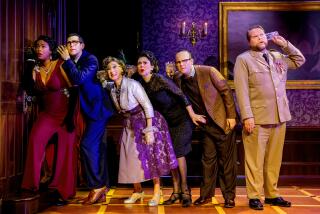Review: ‘Christmas Oratorio,’ Musica Angelica
For some weird reason, Saturday traffic in Los Angeles is as bad, and often worse, than it is during the work week -- and on this particular night, the freeways were loaded up even more than usual.
It was bad enough to delay the start of Musica Angelica’s performance of J.S. Bach’s “Christmas Oratorio” at Zipper Concert Hall, prompting music director Martin Haselböck to wonder aloud whether transportation had improved much since Bach’s day.
In any case, the fatigue of getting there dissipated quickly once Haselböck, his period-performance ensemble and the imported Tölzer Knabenchor from Munich, Germany, launched into the opening chorus, “Rejoice, exult!” This full-ranged Bavarian boys-choir has a big, solid, even at times rugged sound with a hearty rhythmic kick -- and Haselböck could scarcely contain his enthusiasm in harnessing its energy.
Calling Bach’s piece an oratorio is a bit misleading, for it is not a through-composed oratorio at all. Rather, it is a succession of six self-contained Christmas cantatas meant to be performed on six separate days. Also, it is to some degree an assemblage of spare parts from various cantatas and other works -- the most famous being the twice-used tune “Herzlich thut mich verlangen” by Hans Leo Hassler, which Bach also swiped for his “St. Matthew Passion.” The tradition continues to this day; Paul Simon used the melody as the basis of his ironically titled hit song “American Tune.”
Performing all six parts would have made for a very long evening -- especially for the hardworking baroque trumpet corps -- so Haselböck selected only Parts 1, 2, 3 and 6. Placing the double reeds on the extreme right of the stage resulted in striking antiphonal effects against the strings in the Sinfonia that opens Part 2 and perhaps contributed to the exceptional transparency in texture elsewhere.
All of the soprano and alto solos were performed by selected boys from the choir; all had no trouble negotiating the sometimes tricky appogiatura and some awkward intervals at Haselböck’s swift tempos.
Markus Schäfer displayed a lucid, expressive, clearly enunciating lyric tenor, while bass Randall Scarlata -- more of a baritone to my ears -- united in a rousing duet with one of the boy sopranos in Part 3. The trumpeters managed the difficult parts on their valveless instruments well, though they seemed near the end of their tether by evening’s end.
Ginell is a freelance writer.
More to Read
The biggest entertainment stories
Get our big stories about Hollywood, film, television, music, arts, culture and more right in your inbox as soon as they publish.
You may occasionally receive promotional content from the Los Angeles Times.










